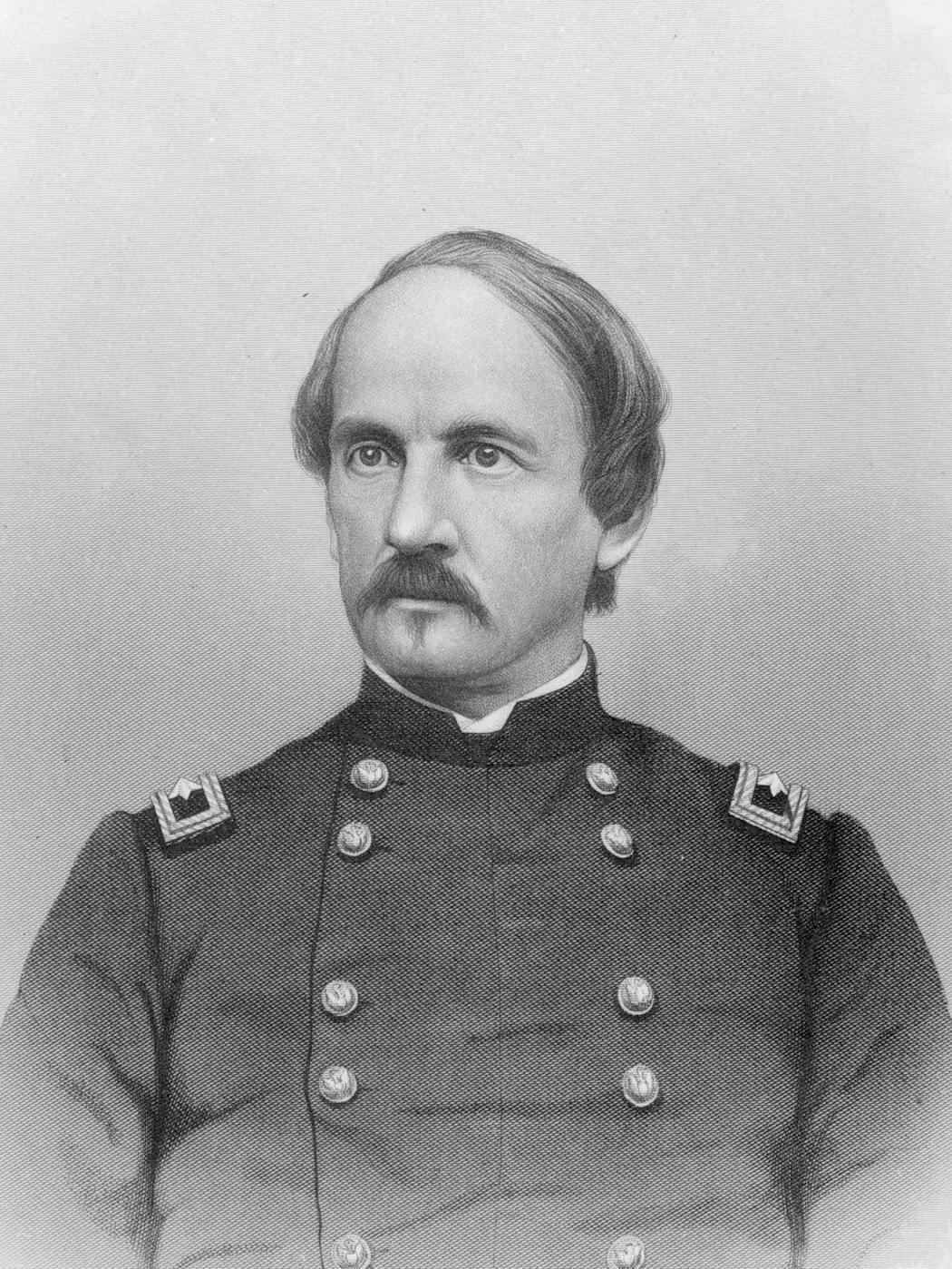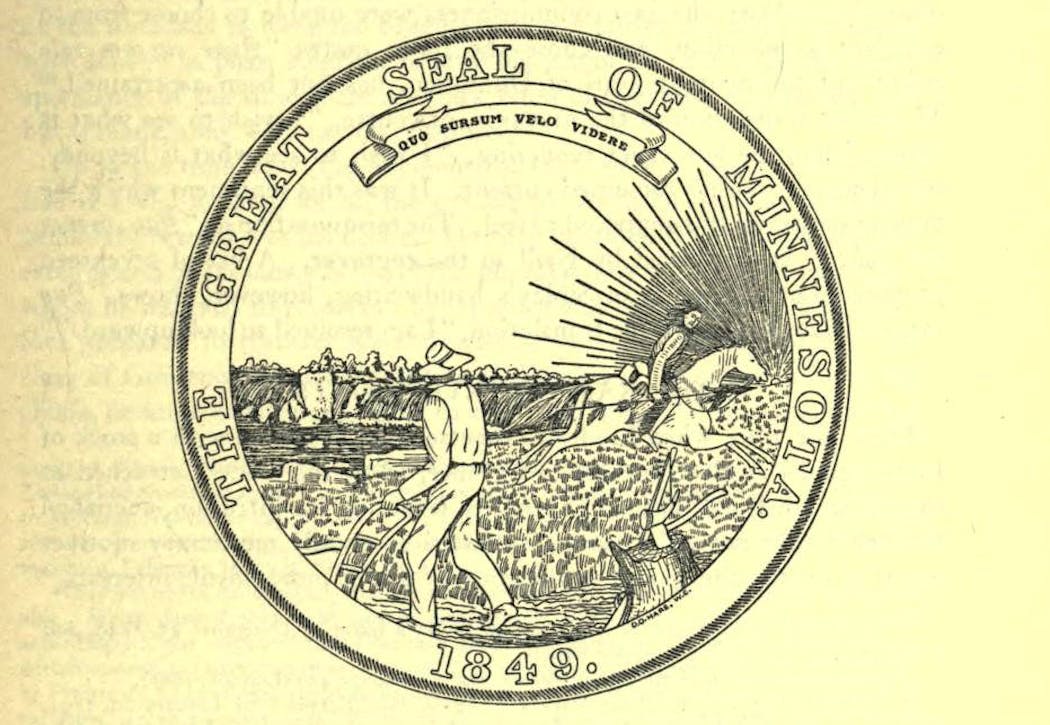Minnesota's state seal and flag are changing. How was this controversial image created?
Listen and subscribe to our podcast: Apple Podcasts | Spotify
Minnesota's state flag has drawn criticism for decades because of its controversial depiction of Native Americans. But the image at the center of that debate is actually an older, lesser-known symbol: the state seal.
The flag and the seal are both being redesigned by a commission acting under orders from the Legislature. It will submit final designs by Jan. 1. Hearing about the commission's work in the news made Jimmy Lonetti want to know more about the origins of the state seal.
"The seal came first and then it was just slapped on a flag to have a state flag," said Lonetti, who lives in south Minneapolis. "It made me wonder, who even designed the thing in the first place?"
Lonetti submitted his inquiry to Curious Minnesota, the Star Tribune's reader-driven reporting project.
The answer dates back to the days when Minnesota was still a territory and a developing nation celebrated the idea that white settlers were destined take over. How those colonial ideas ended up on the state seal is a story that hadn't been fully pieced together until recently.
Bill Convery, director of research for the Minnesota Historical Society, took on the job after the State Emblems Redesign Commission asked him to create a report on the history of the state flag. He realized he couldn't tell that story without also delving into the inception of the seal.
"Nobody asked about the seal," said Convery, who dug deep into the state archives. "But they are so connected."
How territorial pioneers developed the seal
The story begins with the establishment of the Minnesota Territory in 1849, which created a need for a seal to stamp official territorial documents. Convery discovered that Alexander Ramsey, the territorial governor, initially used his own design.
His first version was a sunburst and the motto "Liberty, Law, Religion, and Education." It was soon replaced by a seal showing a Native family handing a ceremonial pipe to a settler. Ramsey wanted the seal to emphasize a peaceful coexistence between white settlers and Native Americans, Convery said.
But Henry Sibley, an ambitious young fur trader who represented the territory in Congress, decided to commission a few alternatives. It was popular at the time for territorial seals to celebrate the idea of manifest destiny — that white Americans were ordained by God to settle across North America.
Army engineer and draftsman John Abert drew up four designs for Sibley, one of which depicted a farmer pushing a plow in the foreground while a Native American man rode on horseback toward the rising sun.
Sibley commissioned a watercolor version of that image from Seth Eastman, a U.S. Army captain who served several stints at Fort Snelling and had become known for his paintings of Minnesota landscapes. When Ramsey saw the painting, he suggested replacing a tree stump near the farmer with a teepee to represent Native American life in the state.
"Even Alexander Ramsey was saying: 'Maybe we are taking this settler imagery too far,'" said Convery. "Henry Sibley just kind of ignored him and doubled down."
Sibley added an axe and rifle instead of a teepee and a Latin motto that, roughly translated, meant: "I wish to see what is beyond." That design was accepted by the territorial Legislature in 1849, becoming Minnesota's official seal.
The next year, Seth Eastman's wife, Mary, wrote a poem about the seal that left little doubt about the message she believed it was sending. Writing the "red man's course is onward," Mary continued: "We claim his noble heritage, / And Minnesota's land / Must pass with all its untold wealth / To the white man's grasping hand."
A controversial brand
After Minnesota became a state in 1858, Sibley continued using a modified version of the territorial seal as the state's first governor. The rider was eventually reoriented to head toward a setting sun in the west — putting an emphasis on the idea that he was getting out of the way of the settler — and he changed the state motto to "L' Etoile du Nord," French for "Star of the North."
Using the territorial seal raised some eyebrows, Convery said, because the state Constitution gave the Legislature the power to create a new seal. Still, legislators eventually adopted Sibley's version because it had become so recognizable through its frequent use over the years.
The seal was the only symbol representing Minnesota until 1893, when the state needed a flag to represent itself at the World's Fair in Chicago. Designers put the seal at the center of the flag and surrounded it with lady slippers — the state flower — and 19 stars to represent Minnesota's place in the union (after the original 13 colonies).
But over the decades that followed, Native American leaders criticized both the flag and the seal for imagery celebrating their removal from the land. To address those concerns, legislators made tweaks to the state seal in 1983, turning the horseman's head toward to the settler and adding language to state statutes that said he represented "the great Indian heritage of Minnesota."
"It was an attempt to legislate the way we think about the symbolism, but nobody really bought it," Convery said.
Criticisms of the seal and the flag regularly resurfaced. Counties, tribes and other government entities started using their own custom seal designs to represent themselves. This spring, the DFL-led Legislature created the State Emblems Redesign Commission, which must come up with a new state flag and seal by Jan. 1 that "accurately and respectfully" reflects state history.
Over time, the official need for a seal on state documents have all but gone away, making its purpose almost exclusively symbolic. The seal appears on some lecterns and placards around the State Capitol.
"Now it's a brand, it's a shorthand symbol for the state of Minnesota," Convery said. "In that sense, I think a lot of people want symbolism that reflects their values."
If you'd like to submit a Curious Minnesota question, fill out the form below:
Read more Curious Minnesota stories:
Did political shenanigans derail an effort to move Minnesota's capital from St. Paul?
Why is St. Paul located where it is? Hint: It involves liquor
Why isn't Minnesota's sacrifice at Gettysburg better remembered?
Why can't Minnesotans bypass the Legislature to change state laws?
How did Minnesota become the Gopher State?
Why isn't Isle Royale a part of Minnesota?







